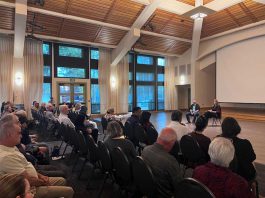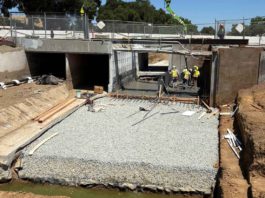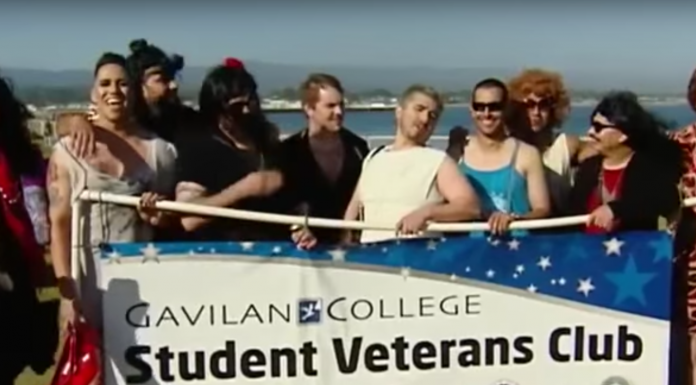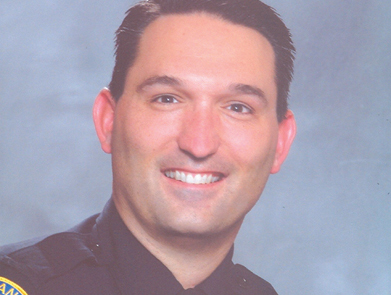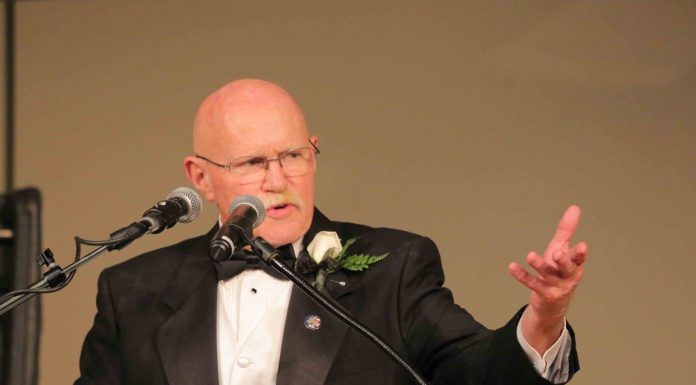Guest view: Walking a mile in her shoes
I’ve adopted several phrases that I use when life gets rough: “Someone out there has it way worse than me,” and “I’m doing this for something bigger than myself.” I used to tell myself these things when things were particularly bad in Afghanistan. I have continually referred to these lines in my time out of the service, however I never thought I’d need to use them while having mascara put on my eyes.At the Gavilan College Veterans Club, we’ve been looking for ways to help out in our community. We want to change the conversation that has become the norm when discussing veterans, especially combat veterans. A couple of months ago at a party, when one of the revelers learned that a friend of mine had done several tours to Iraq he asked him, “Are you alright? Up here?” pointing to his head. He managed to brush it off but, it’s not an isolated incident.Most of us have had someone just assume that we aren’t alright after doing a tour. One of the goals that we at the club wanted to do was put ourselves out there so that we could show combat veterans in a new light. If we could find an opportunity to help our community and simultaneously display that we don’t need to be taken seriously all the time, we win on all fronts.So when our club advisor Jillian Wilson came up with the idea of supporting Walk a Mile in Her Shoes, we all agreed it was a great idea. However, I wasn’t that excited when the suggestion came about for a tiered system of donations. With every monetary goal reached we’d make ourselves a little more feminine, and at $2,500 we’d go full drag.Some of the club members were thrilled (it raised eyebrows, but we don’t judge). I really enjoy being a guy. I grew a beard as soon as I got out of the Army. So the whole process wasn’t thrilling me. The money we would raise would go to Monarch Services (formerly Women's Crisis Support - Defensa de Mujeres), an organization that helps over 1,500 victims of sexual assault and domestic violence a year. So indeed this was “something bigger than myself,” thus it would be worth it.A couple of days away from the event it was clear that we’d make the goal for full drag. To add to the uncomfortability, I recruited my mom to help buy me a dress. It was definitely fun for her.On April 28 about 10 combat hardened veterans showed up at the Cosmetology Department at Gavilan, ready to get dolled up. We were greeted by a very eager team of women who couldn’t wait to get started on us. I was uncomfortable and they couldn’t help but laugh. I think every one of them really enjoyed doing this to us, so I’m not sure if I really need to thank them too much. A special thanks does need to go to Gilbert Ramirez and Michelle Terrano. (I know you did it just to get back at your brother.) By the time we got to Santa Cruz I think it’s safe to say we were all a bit nervous and we were right to be. All 10 of us were gawked at and even cat-called. So ladies, job well done.Our number one earner, Johnny Sandavol, who personally brought in over a grand in donations was probably the best looking out of all of us, if not the most revealing. Hopefully his lovely girlfriend Erika Linn Chesnutis will choose to dress him a little more conservatively next time. Ray Lopez, our team Captain, brought in over $700 just behind myself, although in my opinion he should redo the mile since he looked more like an 80s glam metal star.The biggest guy we got, Jake Hester, pulled in about a couple hundred. He ended up looking like a cross dressing Fred Flintstone. Jorge Gonzales was dubbed a cholo drag queen before we even left the campus. Thanks for giving me something to laugh at. Josh Santorro, with his waxed mustache and betty boop outfit, will forever haunt my dreams. Ben Sandavol went for a Marilyn Monroe look.Somebody described me as drag queen hippie Jesus; I’ll take it. In total we all raised $4,757, nearly doubling our original goal to walk a mile dressed in drag.It also wouldn’t be fair not to mention the women who joined us on this walk: Mayra Rios, Ray’s wife Elaine Estrada, Melissa Santorro, and of course my mother.The true title of queen of our group goes to Jillian Wilson as she’s the one who encouraged us to do this. A very special thanks goes out to Leeann Luna the Monarch Services Administrative Manager who was responsible for putting on this year's Walk a Mile in Her Shoes event.This was an eye opening experience. I’m happy that I did it. Even if I did exaggerate how uncomfortable I was, I’d still not like to do it again. Next year I think I’ll just stick to the shoes.Gilroy resident and Live Oak High alumnus Connor Quinn is Region IX State Membership Coordinator for Team Rubicon, a disaster relief organization that employs military veterans. He is also a VA work study at the Gavilan College Veterans Resource Center.
Guest view: Nothing like a mother’s love
There really is nothing like a mother’s love, right? I’d like to tell you a little story about how my mom helped forge me into the strong-willed, can-do man I am today.
Guest view: Shine a blue light for fallen police
For many Californians, the term “Honor Roll” conjures up images of academic excellence and the proud feelings associated with seeing your name included on a prestigious list. For those of us in law enforcement, the “Honor Roll” is not a list on which we want to find our names. Although this list also gives rise to feelings of pride, it is the list of California peace officers killed in the line of duty. So far this year, 33 names have been added to the Honor Roll nationwide.Each year, the California Peace Officers’ Memorial Foundation holds a ceremony to honor the men and women in law enforcement who have made the ultimate sacrifice and joined the list that year. The numbers vary from year to year, but since 2001, the names of 159 California Police Officers have been added to the Peace Officers’ Memorial Monument in Capitol Park in Sacramento. Those names are also included in the National Law Enforcement Officers Memorial in Washington, D.C., and are joined by thousands of others. These brave men and women are honored each year in our nation’s capital during National Police Week in May. This year, May 15 will be recognized as National Peace Officers Memorial Day.Those of us who chose law enforcement as a career start each day with a desire to serve and protect our communities by putting the safety of others before our own. We are husbands, wives, fathers, mothers, sons, daughters, brothers and sisters. We are coaches, counselors, mediators and mentors. We dedicate ourselves to fighting crime and drugs to create a safe community for those we serve. We help at-risk youth in schools as well as parents in crisis, and connect the homeless and mentally ill with services. We show up when you call 911 to help you in a time need or an emergency. We do these things with the understanding that it’s part of our job and we are proud to serve our community.The men and women of our department care deeply for Morgan Hill and demonstrate that care through various community engagement efforts—often on our own time. We also strive to decrease crime and ensure a high quality of life through proactive and intelligence based policing strategies.We are grateful to serve a community that supports its police department. I encourage you to show your support during National Police Week, the week of May 15, by shining a blue light to honor those who have made the ultimate sacrifice in service to their community and to show your local heroes how much they are supported by those we serve.On behalf of the men and women of your Morgan Hill Police Department, thank you for the opportunity to partner with you to provide a safe environment in which to live, work and play.David Swing is the Chief of the Morgan Hill Police Department.
Guest view: Support public safety at April 30 Cops and Robbers Ball
Like all communities, public safety is of utmost importance here in Morgan Hill. At the top of the public safety list is our police department. They not only enforce our laws; they do so much more to establish a feeling of safety in our community. By being out on patrol, officers establish a sense of comfort and safety for our residents. Our officers are in our schools, interacting with kids on a personal basis, forming personal relationships that pay dividends in avoiding gang involvement.Although our PD is fully staffed, we need all the help we can get to assure that the feeling of safety in Morgan Hill stays vibrant. Volunteers are a huge part of making that happen. Our volunteer CERT (Community Emergency Response Team) is trained and ready to help on emergency situations. The Explorer program trains and uses young adults to supplement our officers when additional personnel are appropriate. The Volunteers in Policing (VIP) program trains citizens to support the department by doing administrative tasks and supplementing them on patrol. The PD also relies on residents to form Neighborhood Watch groups and report any situations requiring police intervention.The notion of community policing is that everyone is involved in keeping our city safe.There is one other group that is extremely supportive of our policing efforts: the Community Law Enforcement Foundation, or CLEF. They raise money to donate to the PD for very specific purposes. The most notable example is our canine unit—the dog, Basco, his training and all his food and equipment is funded by CLEF. CLEF also funds equipment, like license plate readers, that allow our officers to take advantage of the latest technology for law enforcement. Another area of funding provided by CLEF is for training, not only for our officers, but for citizens as well, including the very successful Parent Program.So you are probably wondering where CLEF gets the funds it uses to support our PD? Well, take out your wallet and prepare to have a whole bunch of fun! The annual Cops and Robbers Ball is coming up April 30 and it is truly a BALL! What better cause can there be than to support public safety in your home town by providing funds to this great organization that does so much for the MHPD, making us all safe.And what a great evening it is. CLEF has been doing this for a number of years and event chair Sharon Daniel knows how to do it right. A great dinner followed by a brief but meaningful presentation of the annual Public Safety Award, honoring Mike Johnson and Frank Thomas for their stellar support of CLEF and our MHPD, followed by dancing. There is a live and a silent auction and some additional fun opportunities to spend money in support of this great cause.Please treat yourself to a really fun evening while helping to keep Morgan Hill safe.The Cops and Robbers Ball will take place 5:30 to 11 p.m. April 30 at the Community and Cultural Center, 17000 Monterey Road. Tickets cost $95 and are available online at morganhillclef.org or from Craig C. Van Keulen at Van Keulen & Van Keulen, 17600 Monterey Rd., Second Floor, Morgan Hill, CA, or by calling Sharron Daniel at (408) 891-7795. Steve Tate is the Mayor of Morgan Hill.
Letter to the editor: District tried to limit public participation in charter discussion
On March 15, 2016, the Morgan Hill Unified School District board of education held a meeting in which Superintendent Steve Betando informed the board and the public of his recommendation that the newly opened Voices Charter School be co-located upon the site of the Charter School of Morgan Hill. This decision is a momentous one which will impact hundreds of students and families. As such, parents and teachers from Voices and The Charter School of Morgan Hill attended this meeting to hear what Mr. Betando had to say, and to express their own concerns.We are writing from the perspective of the parents and teachers who were relegated to the overflow room and warehouse during the March 15 MHUSD Board meeting. There were over 200 people who had to watch the meeting via a TV monitor from these auxiliary rooms. Many of us have attended past meetings where the board room has been very crowded and people have been allowed to stand around the perimeter, sit on the floor and view the meeting from the hallway. We attended this meeting because we wanted our presence to be felt and heard by the board and district staff, and we were denied this opportunity. We feel especially disappointed because there were multiple requests made to Mr. Betando last week to move the meeting to a venue which would accommodate the expected crowd. We feel that this request was purposefully denied. We also feel that Mr. Betando orchestrated the setup to shield the board and squelch our ability to demonstrate our voice as a united front. Seats remained open in the board room for the entire meeting that members of our community were not allowed to access because they did not have the correct number on a sticker. Instead, many of us viewed the meeting from a room where the sound quality was so poor that it was difficult to hear the dialogue, and the lights kept flickering on and off. The California legislators have passed the Brown Act for the purpose of facilitating public participation and it is through this type of participatory democracy, debate and discussion that the best ideas will emerge. Instead of embracing this through a simple change of venue, it appears that the district did everything in their power to limit this participation rather than encourage it.Signed by 212 CSMH parents, teachers and community members.
Guest view: Helping homeless protects creeks
A booming real estate market has benefitted many in Santa Clara County, but many others have not been so fortunate. Homelessness here in one of the most expensive housing markets in the country is a problem that affects everyone. Thousands of individuals and families are currently homeless, and hundreds have resorted to living alongside our local creeks.
Guest view: Let’s hear it for Santa Clara County agriculture
It is exciting to see so many members of the community in defense of open space, and in particular, productive open space such as that used in agriculture. As a second generation farmer from Santa Clara County it is great to see. But as a grower, I wish there was more understanding of how agriculture operates safely for our community and the consumers, as well as the diverse benefits it returns to the community.A frequently asked question comes up: “What is the health of the agricultural community?”At first thought, you may not believe farming and ranching are doing very well. Such endeavors are more and more hidden from Santa Clara County as open space is replaced by asphalt, concrete, roof lines and other structures.The answer is more complex for urban edge farming; but, fortunately, the county has an Agricultural Commissioner—Mr. Joe Deviney—whose forward thinking has brought about great answers to this complex question. In collaboration with ERA Economics and help from local growers and ranchers, a good answer was brought forward through sound economic analysis to quantify Santa Clara County’s Ag Value. Ag’s valuation to Santa Clara County was 8,150 jobs and $1.6 billion in economic stimulus. That’s a lot more than any of us in the industry expected.Agriculture is incredibly responsive to the needs of the community and is currently doing very well. That’s not to say there are some large threats to the health of these industries, but for now it is showing signs of stabilization. How well is well? Here are some highlights to the report:• The resource base of agricultural land declined significantly in the 1980’s and 1990’s, but has recently stabilized. The value per acre and the value per worker created by Santa Clara County agriculture has continued to increase and has never been higher.• Agriculture provides diverse, stable employment opportunities for both skilled and unskilled laborers.• Like the other high-tech industries in Santa Clara County, agriculture is growing in productivity per worker and per land unit.• The Santa Clara County Open Space Authority estimated that the total value of Santa Clara County natural capital exceeds $45 billion. Agriculture preserves some of these vital natural processes and adds to the character of the county.• Agriculture can be viewed as self-financing open space, providing important ecosystem service values to county residents.Santa Clara County needs to continue with the stabilization of productive open space.When asked about land use policies, mitigation and how best to use areas for productive open space such as farming, ranching and other agricultural uses, the California Farm Bureau Federation uses language in a way that best represents growers’ and ranchers’ thoughts in the following statement: “Proposals to use agricultural land for mitigation should be considered by each county farm bureau on their own merits on a case-by-case basis. CFBF supports the use of voluntary agricultural conservation easements, when mitigation is required for farmland conversion. We oppose government mandated deed restrictions or easements acquired by the use of eminent domain. Subsequent easements granted on lands with agricultural easements should not restrict or reduce the agricultural productive capacity of the land, including crop choice.”The efforts of notable agriculture families, such as the Chialas, is generous and real. Many counties are discovering ways to integrate and weave agriculture into the community. Santa Clara County ought to do the same. Much applause and gratitude should be lauded on those—private and public—who entertain such ideals and work toward improving our community because the environment will benefit.How you may ask? Equally important are the ecosystem benefits attributed to open space areas. And agriculture plays a role in delivering these benefits to surrounding communities, free of charge.Ecosystem benefits include: flood control, groundwater recharge, water quality, pollination, biodiversity and open space. These benefits are easily overlooked but have measurable values for our community.So the next time you visit your favorite local nursery, winery, pumpkin patch or farmers market, be sure to thank them for doing great things for the economy, environment and the community’s health.We surely love to hear it! Working towards a balanced, healthy community benefits all.Erin Gil is a second generation farmer and owner of the Grass Farm in Morgan Hill. To read the report “The Economic Contribution of Agriculture to the County of Santa Clara,” visit sccgov.org/sites/ag/news/Documents/AG_Economic_Report_WEB_Final.pdf.
Guest view: Urban expansion encroaches on rural San Martin
Do you ever wonder about the fate of San Martin? Many who live in this rural, unincorporated community certainly do. Annexation proposals and Urban Service Area boundary requests, submitted by the Cities of Morgan Hill and Gilroy, have been unsettling to those within the unincorporated areas.
Guest view: County has unique interest in Delta health
Here in Santa Clara County, more than half the water we use is “imported,” meaning it’s conveyed to us from other parts of the state.Most of that water starts out as snow in the Sierra Nevada. When it melts, it makes its way into large reservoirs like lakes Oroville and Shasta.From these reservoirs, the water flows in rivers to the Sacramento-San Joaquin Delta where it is then conveyed through state and federally run infrastructure known as the State Water Project and Central Valley Project to us and other southern, central and coastal parts of the state.That close to half the water we use in Santa Clara County comes through the Delta means the health of the Delta is extremely important to us and should be a concern to everyone. But the Delta is quavering under pressure from aging levees, sea level rise and human and environmental demands. So we have been working with other water agencies, state and federal agencies, and other stakeholders to evaluate options.There have been a number of plans throughout the years to improve the health of the Delta and to try to meet the demands of urban and agricultural users and the environment. The latest is a pair of proposals by the state, called California WaterFix and California EcoRestore. The WaterFix plan aims to change the way water moves south through the Delta in an effort to safeguard drinking water and improve water flows for the environment. The EcoRestore plan aims to restore at least 30,000 acres of habitat by 2020 to benefit the Delta environment.The Santa Clara Valley Water District Board of Directors is poised to make a decision on whether to support the WaterFix plan and whether to participate in it sometime this year. But before we can do that, we want to be sure we—and the public—fully understand it.That’s why we held a special workshop Jan. 26, where we invited representatives from the state Department of Water Resources, the California Natural Resources Agency and the state Department of Fish and Wildlife to present more information on this plan for the Delta. If you missed it, our board meetings are webcast and archived online for later viewing.Board members asked a number of questions, ranging from cost to governance to environmental impact, and we also heard from members of the community who voiced concerns and asked questions. This is an important part of the process, and we have more workshops and committee meetings planned to learn much more about this proposal and what benefits or challenges it could pose to our county, as well as how much it would cost to participate. These workshops and meetings are open to the public, and we invite you to attend so you too can learn more and provide input. The state of our water concerns everybody.Our next discussion of the plan is scheduled for a Feb. 22 meeting of our BDCP Ad Hoc Committee. Check back at valleywater.org for final dates and times. You can submit feedback to [email protected] Varela is Vice Chairman and District 1 Director of the Board of Directors for the Santa Clara Valley Water District. For further information, contact Varela [email protected].
Guest view: LAFCO should reject SE Quad plan
The City of Morgan Hill’s plan to develop county farmland to preserve it lacks merit. It undermines broader regional efforts to enhance and protect productive farmlands throughout our valley. Dominated by financial self interests, the city has pushed forward a fiscally and environmentally irresponsible plan that will hasten the demise of local farming. With the impending effects of climate change, preserving our farmlands becomes crucial. This is why on March 11, the Local Agency Formation Commission (LAFCO) must vote to deny the city’s plan.The city is seeking LAFCO approval to annex 229 of acres of farmland in the county for commercial development to fund preservation. But the funding plan is flawed and grossly inadequate according to the Santa Clara Valley Open Space Authority and American Farmland Trust, and LAFCO concurs. The city has 45 years’ worth of vacant commercial land within its current boundaries. It can use those lands and not develop any farmland at all.As the city touts its preservation policies, it has declined to work with the OSA, the county and LAFCO to address concerns they have with the plan.So what is the city’s plan? There is no plan. There are few if any viable projects proposed for the lands to be annex. If LAFCO approves the city’s request, the city can simply abandon the plan and rezone for commercial and residential use. There is no guarantee than any farmland will be preserved.The city has proposed a terrible recipe for 21st century urban sprawl. It’s greed, not need. And that puts our region at risk of losing an invaluable and finite resource, at risk of lowering our quality of life, at risk of damaging an important and valued economic industry in our valley. In fact, the county agricultural commissioner has recently reported, “The value per acre and the value per worker created by Santa Clara County agriculture has continued to increase and has never been higher.”Southern Santa Clara County contains the majority of farmlands in the county and their value cannot be understated. Our farmlands are utilized throughout the year. They are supported by a unique groundwater basin. They are well suited to lessen the effects of climate change through carbon storage, water retention, flood protection, local food production, habitat and biodiversity.The lands in question are county lands. While the cities have a part in protecting farmlands, it is the county that is in the best position to ensure a coordinated effort. The city’s piecemeal plan undermines all farmland at the cusp of regional efforts to preserve.Please add your voice to theirs and send an email to LAFCo before March 11th c/o Executive Director, [email protected] to urge LAFCo to deny the City’s proposal.Mark Grzan is a Morgan Hill resident and former City Councilmember.


